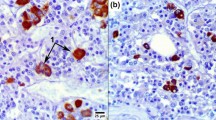Summary
Silver-stained nucleolar organizer regions (AgNORs) were studied in thymic sections from 4- and 30-day-old rats. By direct examination under the light microscope cells with a low or high content of AgNORs (type I and type II cells, respectively) were identified and their relative numbers calculated. The mean area of AgNORs per cell was calculated for each type of cell and age group. Additionally, the proportion of cells labelled with bromodeoxyuridine was calculated in sections from the same animals. Visual identification of type I and type II cells was confirmed by a significant (p < 0.01) difference in the mean AgNOR area in both types of cell. Both the proportion of cells with a high expression of AgNORs (type II cells) and that of bromodeoxyuridine-labelled cells were significantly greater (p < 0.01) in 4-day-old rats than in 30-day-old rats. A significant correlation was found between both variables (R2 = 0.45;p = 0.002), the relation being best between both variables and age (R2 = 0.91;p = < 0.001). These data offer support for an easy interpretation of the AgNOR reaction in which the proportion of cells with a high expression of AgNORs can be used as an index of proliferative activity in a tissue sample.
Similar content being viewed by others
References
Ayres,J. G.,Crocker,J. G. &Skilbeck,N. Q. (1988) Differentiation of malignant from normal and reactive mesothelial cells by the argyrophil technique for nucleolar organizer region associated proteins.Thorax 43, 366–70.
Carbajo,S.,DelPozo,F. &Carbajo-Perez,E. (1992) Quantification of the cellular proliferation on freshly dispersed cells from rat anterior pituitaries afterin vivo andin vitro labelling with bromodeoxyuridine.Histochem. J. 24, 137–43.
Carbajo,S.,Orfao,A.,Vicente-Villardon,J. L. &Carbajo-Perez,E. (1993) Expression of silver-stained nucleolar organizer regions is coupled to cell cycle in rat thymic cells.Cytometry 14, 46–52.
Cibull,M. L.,Heryet,A.,Gatter,K. C. &Mason,D. Y. (1989) The utility of ki-67 immunostaining, nucleolar organizer region counting, and morphology in the assessment of follicular lymphomas.J. Pathol. 158, 189–93.
Crocker,J. &Nar,P. (1987) Nucleolar organizer regions in lymphomas.J. Pathol. 151, 111–8.
Crocker,J.,Macartney,J. C. &Smith,P. J. (1988) Correlation between DNA flow cytometric and nucleolar organizer region data in non-Hodgkin's lymphomas.J. Pathol. 154, 151–6.
Derenzini,M. &Ploton,P. (1991) Interphase nucleolar organizer regions in cancer cells.Int. Rev. Exp. Pathol. 32, 149–92.
Derenzini,M.,Romagnoli,T.,Minigazzini,P. &Marinozzi,V. (1988) Interphase nucleolar organizer region distribution as a diagnostic parameter to differentiate benign from malignant epithelial tumors in human intestine.Virchovs Arch. (B) 52, 334–40.
Derenzini,M.,Pession,A.,Farabegoli,F.,Trere,D.,Badiali,M. &Dehan,P. (1989) Relationship between interphasic nucleolar organizer regions and growth rate in two neuroblastoma cell lines.Am. J. Pathol. 134, 925–32.
Derenzini,M.,Pession,A. &Trere,D. (1990) Quantity of nucleolar silver-stained proteins is related to proliferative activity in cancer cells.Lab. Invest. 63, 131–7.
Egan,M.,Freeth,M. &Crocker,J. (1988) Intraepithelial neoplasia, human papilomavirus infection and argyrophilic nucleoprotein in cervical epithelium.Histopathology 13, 561–7.
Hall,P. A.,Crocker,J.,Watts,A. &Stansfeld,A. G. (1988) A comparison of nucleolar organizer region staining and ki-67 immunostaining in non-Hodgkin's lymphoma.Histopathology 12, 373–81.
Howell,W. M. &Black,D. A. (1980) Controlled silver staining of nucleolus with protective colloidal developer: a one step method.Experimentia 36, 1014–5.
Ploton,D.,Menager,M.,Jeannesson,P.,Himber,G.,Pigeon,F. &Adnet,J. J. (1986) Improvement in the staining and visualization of argyrophilic proteins of the nucleolar organiser region at the optical level.Histochem. J. 18, 5–14.
Ploton,D.,Visseaux-Coletto,B.,Canellas,J. C.,Bourzart,C.,Adnet,J. J.,Lechki,C. &Bonnet,N. (1992) Semiautomatic quantification of silver-stained nucleolar organizer regions in tissue sections and cellular smears.Anal. Quant. Cytol. Histol. 14, 14–23.
Rüschoff,J.,Plate,K. H.,Contractor,H.,Kern,S.,Zimmermann,R. &Thomas,C. (1990) Evaluation of nucleolus organizer regions (NORs) by automatic image analysis: a contribution to standardization.J. Pathol. 161, 113–8.
Underwood,J. C. E. (1992) Nucleolar organizer regions. InAssessment of Cell Proliferation in Clinical Practice (edited byHall,P. A.,Levison,D. A. &Wright,N. A.) pp. 161–75. London: Springer-Verlag.
Author information
Authors and Affiliations
Rights and permissions
About this article
Cite this article
Carbajo-Perez, E., Alberca, V., Vicente-Villardon, V. et al. Expression of argyrophilic nucleolar organizer regions (AgNORs) can be used to assess cellular proliferation as shown in rat thymic sections. Histochem J 25, 548–553 (1993). https://doi.org/10.1007/BF02388062
Received:
Revised:
Issue Date:
DOI: https://doi.org/10.1007/BF02388062



